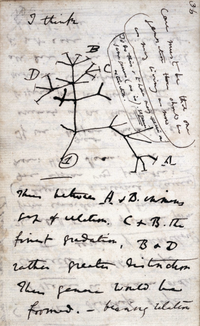
Photo from wikipedia
Abstract There have been over 25 independent unicellular to multicellular evolutionary transitions, which have been transformational in the complexity of life. All of these transitions likely occurred in communities numerically… Click to show full abstract
Abstract There have been over 25 independent unicellular to multicellular evolutionary transitions, which have been transformational in the complexity of life. All of these transitions likely occurred in communities numerically dominated by unicellular organisms, mostly bacteria. Hence, it is reasonable to expect that bacteria were involved in generating the ecological conditions that promoted the stability and proliferation of the first multicellular forms as protective units. In this study, we addressed this problem by analyzing the occurrence of multicellularity in an experimental phylogeny of yeasts (Sacharomyces cerevisiae) a model organism that is unicellular but can generate multicellular clusters under some conditions. We exposed a single ancestral population to periodic divergences, coevolving with a cocktail of environmental bacteria that were inoculated to the environment of the ancestor, and compared to a control (no bacteria). We quantified culturable microorganisms to the level of genera, finding up to 20 taxa (all bacteria) that competed with the yeasts during diversification. After 600 generations of coevolution, the yeasts produced two types of multicellular clusters: clonal and aggregative. Whereas clonal clusters were present in both treatments, aggregative clusters were only present under the bacteria treatment and showed significant phylogenetic signal. However, clonal clusters showed different properties if bacteria were present as follows: They were more abundant and significantly smaller than in the control. These results indicate that bacteria are important modulators of the occurrence of multicellularity, providing support to the idea that they generated the ecological conditions‐promoting multicellularity.
Journal Title: Ecology and Evolution
Year Published: 2018
Link to full text (if available)
Share on Social Media: Sign Up to like & get
recommendations!